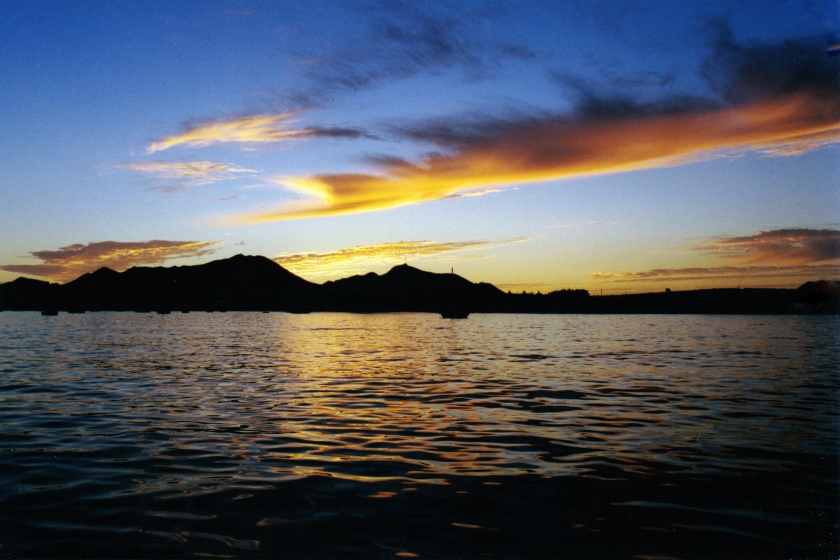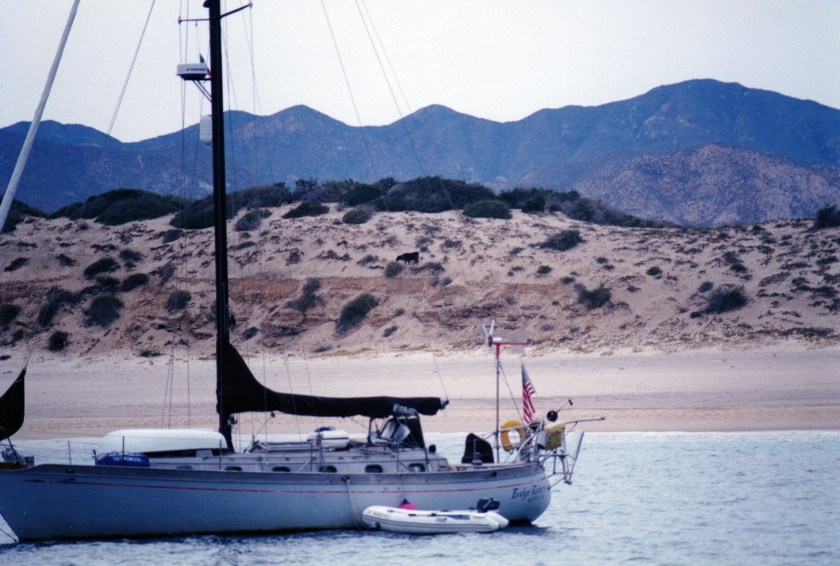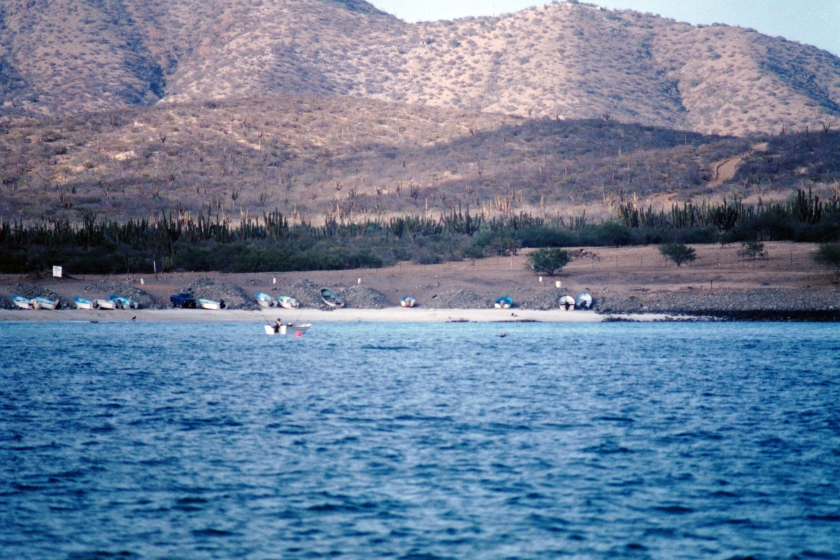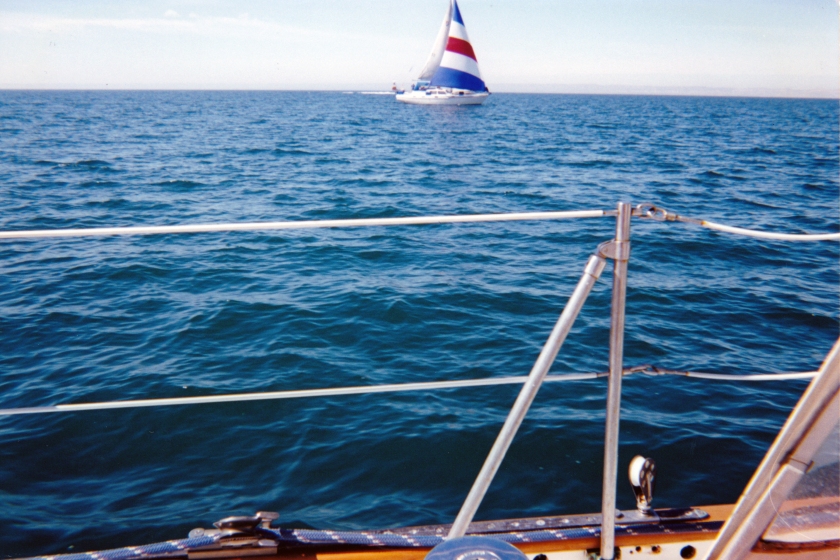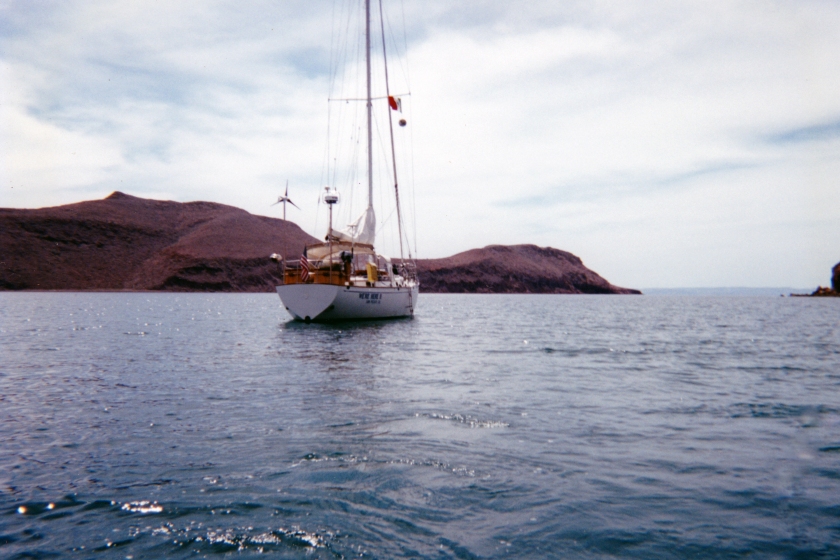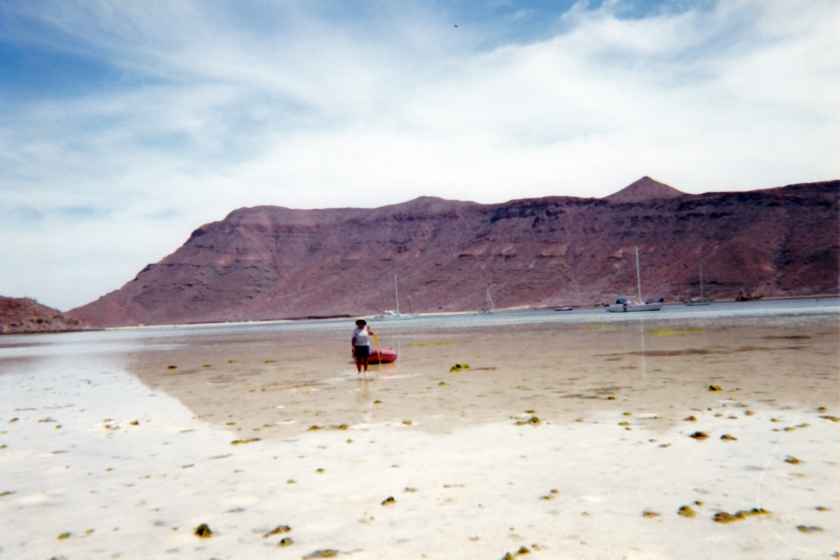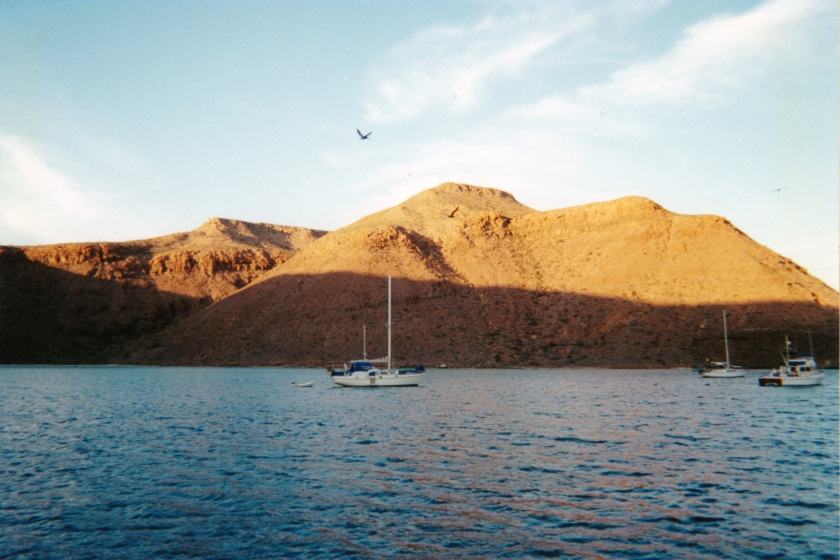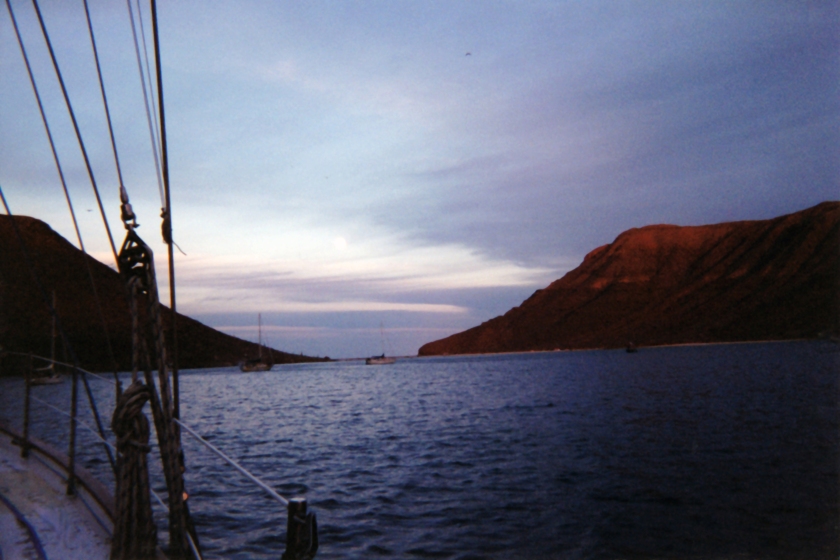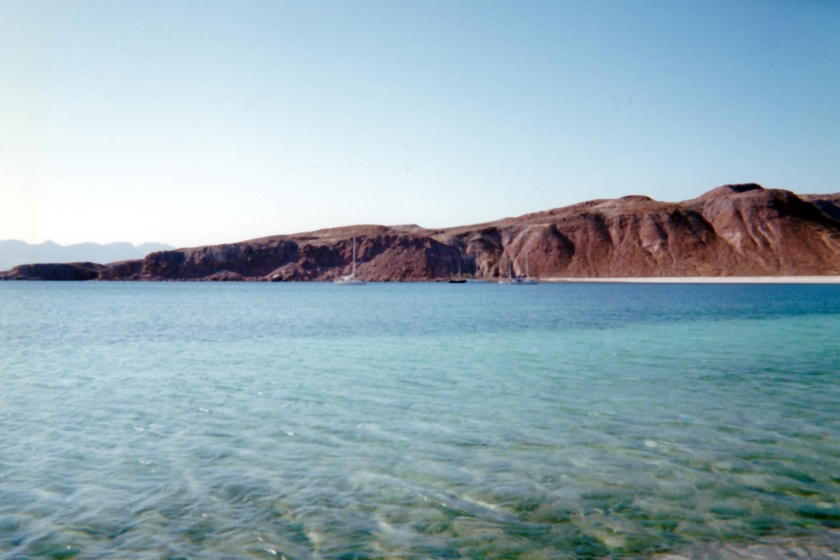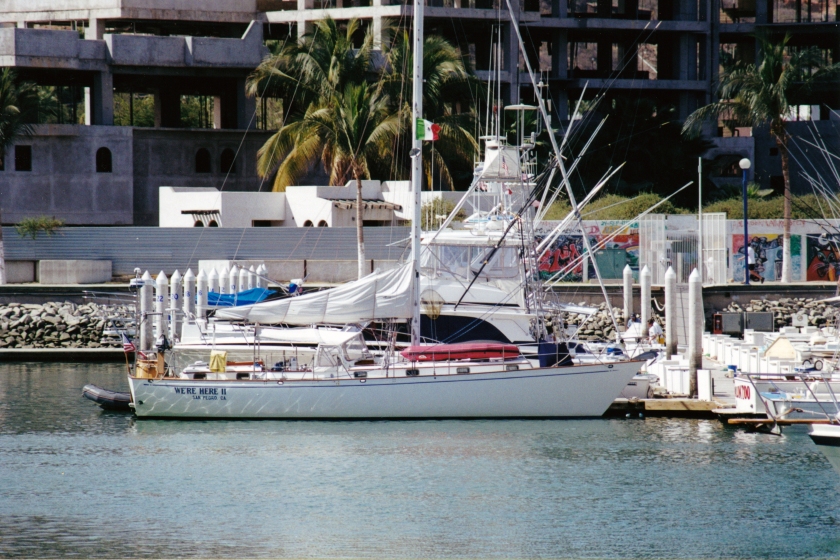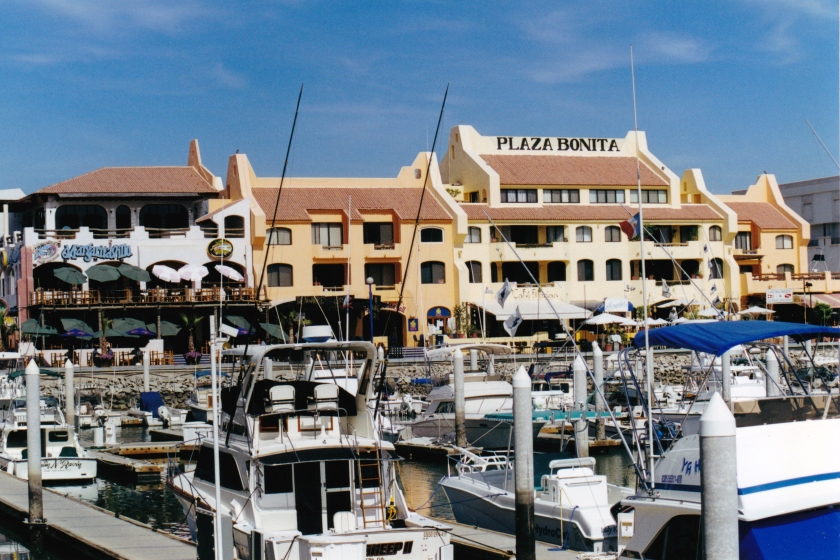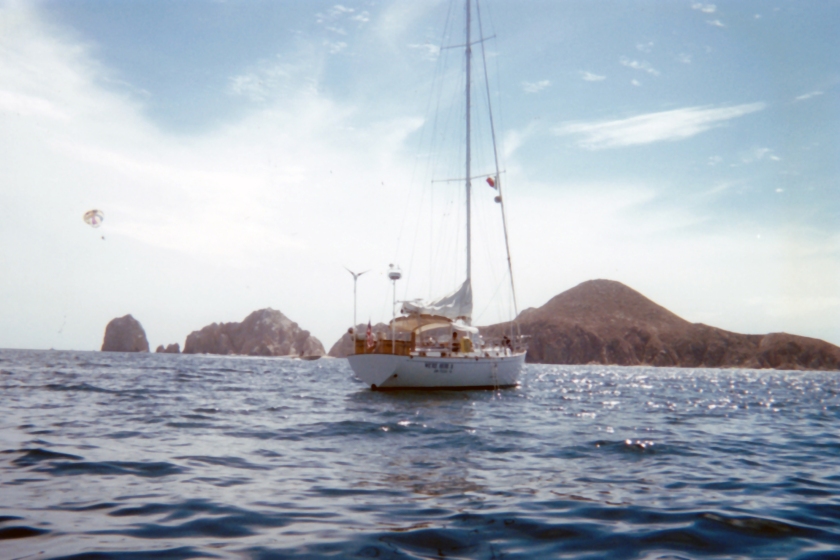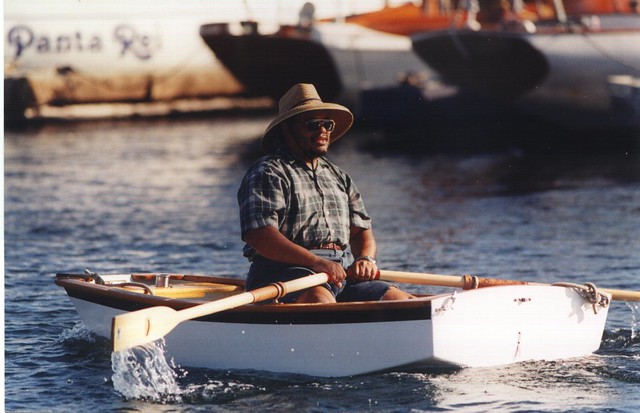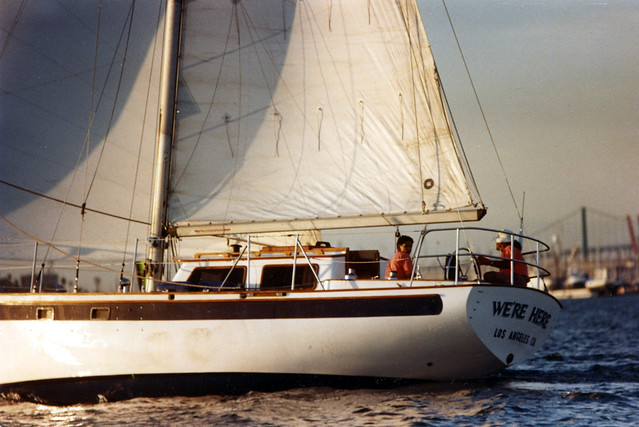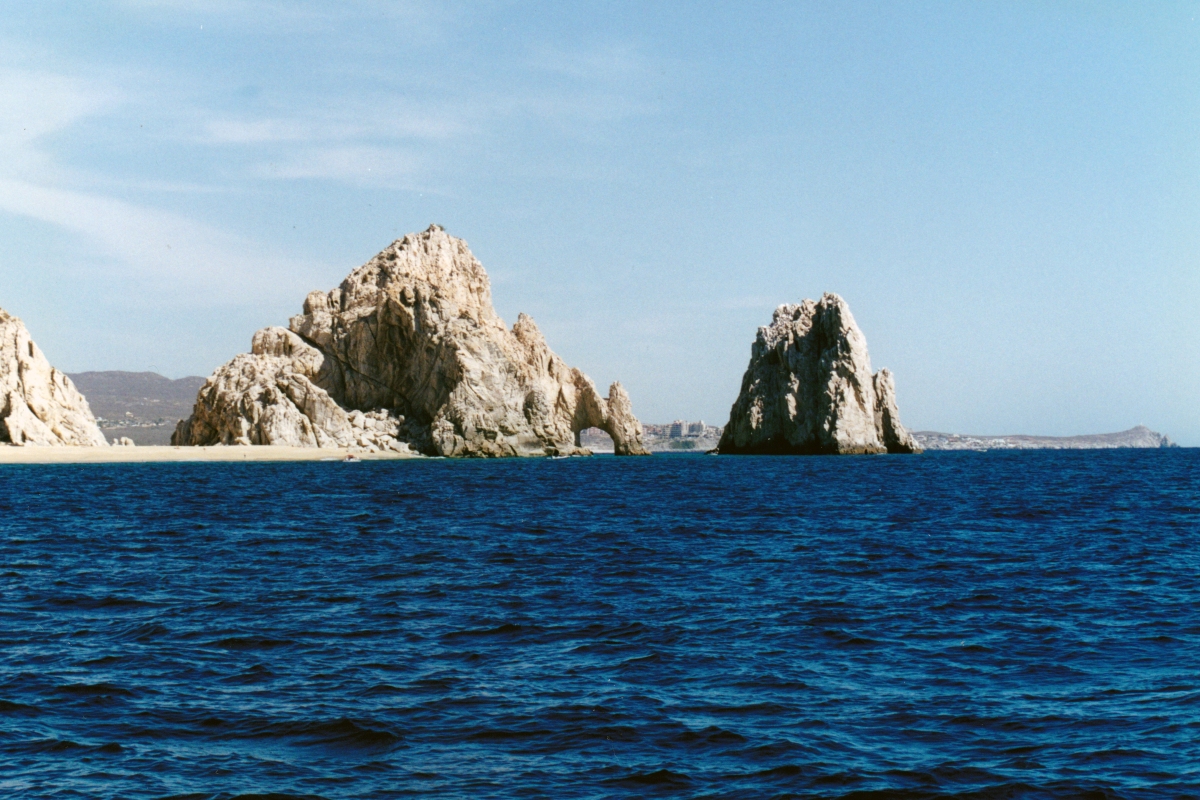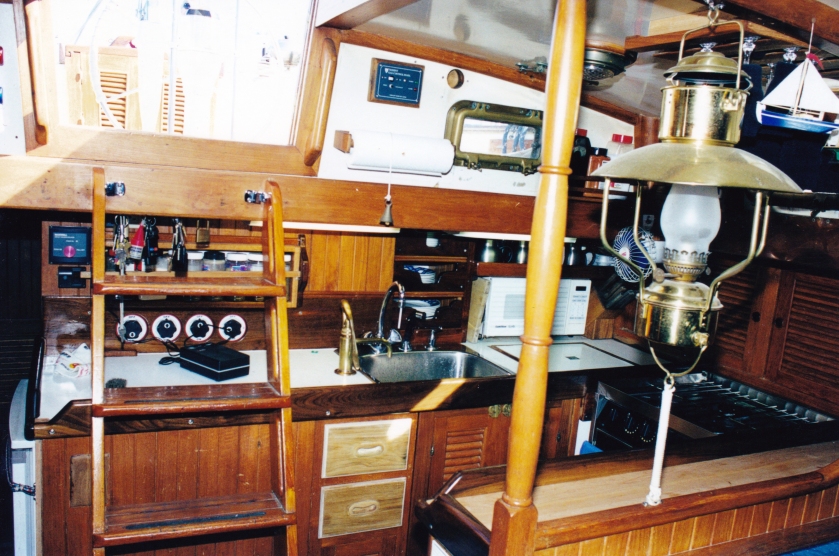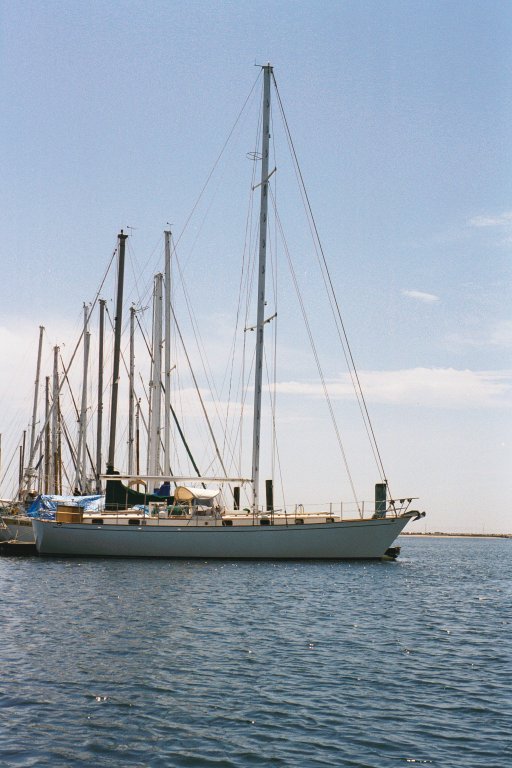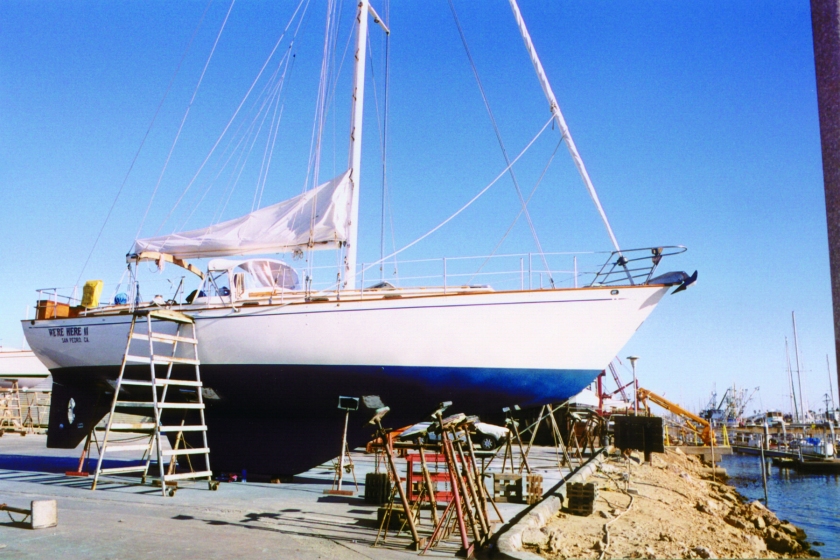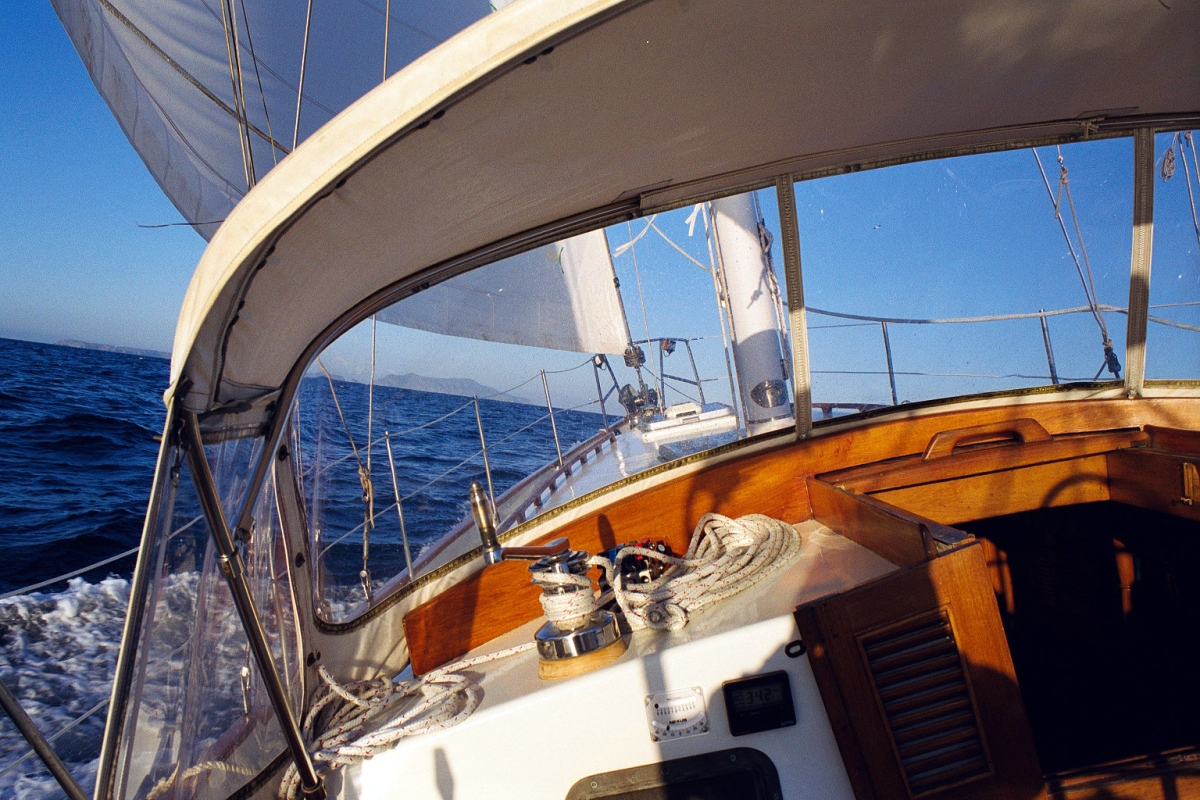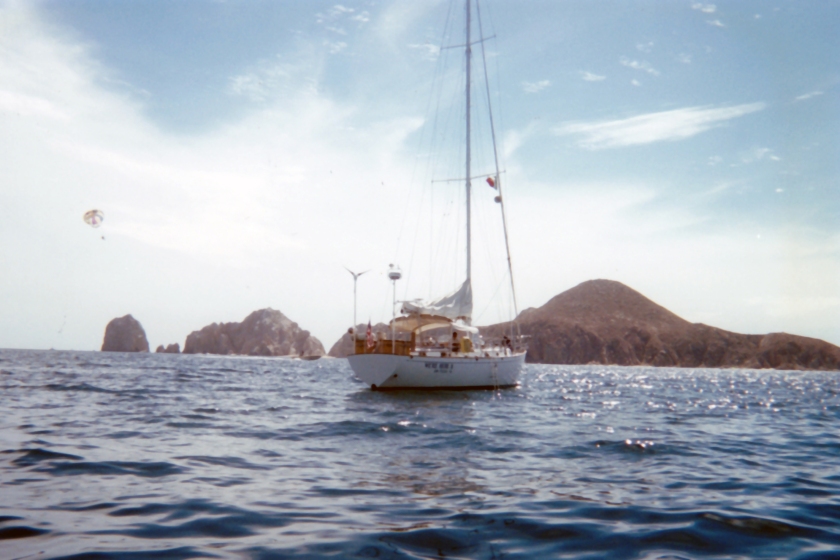We had scheduled ourselves to leave Marina De La Paz on Monday, March 26th, but we got lazy, complacent, and just a little ticked off that we couldn’t stay a bit longer. We had hooked into the cable system and the only channels that came in clearly were TNT and CNN. TNT was endlessly running “Home Fries” and CNN was broadcasting news of yet another school shooting back home. Not exactly the kind of encouragement needed to get us highly motivated.
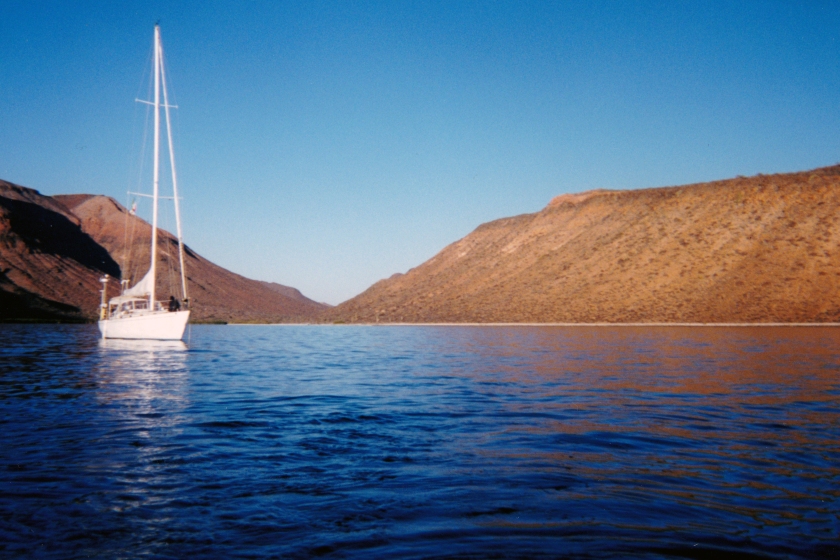
We had dinner on Saturday night at the Hotel Los Arcos with friends we met at the islands, Fran and CC from “La Paloma” (3)[1] and, of course, Monica and Eldon from “Quasar”. The specialty of the house was chateaubriand for two with a Caesar salad. We long ago learned to never order mixed drinks in Baja since they are normally more expensive than the meal. The total for the admiral and myself was all of 25 dollars with four beers but not including the tip. The setting couldn’t have been better, as we were seated where we had an unlimited view of the boats swinging at anchor in the harbor and the evening breeze had just started to cool the city off.
We could have just as easily used the weather as an excuse… the Yuma low had taken up permanent residence in northern Arizona and caused the northwesterlies which had fought us on the way up to change to southeasterlies and block our return home. The truth though, is that dynamite would have had a hard time blowing us out of there. We could have also blamed Lopez Marine or Carlos’ water works for the delays; the impeller for our outboard was due in from Lopez and the “water works” is the local dive service I hired to change our prop zinc. The truth, however ugly, is that we simply did not want to go home. Had the admiral or myself found suitable employment we’d be there now.
We wound up staying five nights in the marina, another night anchored off the Bercovich boat yard and three more nights at Puerto Balandra before we could commit to the voyage home.
It was during those last three days that we came to momentarily regret our decision to go anywhere anytime. You see we hit this freaking huge blippity-blip… well, let me start somewhere near the beginning. Our friends told us the best place to wait out the southerlies was at Caleta Lobos. We’re game, we went there, we anchored, we were damn near eaten alive by the flies. We tried lighting our citronella bombs. The flies got high off the fumes and started biting everything. Us, our cat, the boat, the water. Even chewed our anchor as we hauled it in and split. Luckily as we were leaving a huge motor yacht pulled in and distracted the bugs long enough for us to make a clean getaway. We headed up to the next cove, Puerto Balandra, because we had spent two nights there on the way in and felt it had the most to offer. What we didn’t realize was that it also offered a rock ridge blocking the southern entrance. Well, we found it. We found it the hard way to be sure.
I remember looking off to the left and seeing sea grass floating on the surface much the same as you or I would see kelp paddies at home. It’s not necessarily a bad thing, you just don’t want to run through it. At home kelp caught on your keel can slow you a knot or two. Down here there are often fishing floats, netting, and other lines tangled in it. We turned right to avoid it. WE HIT! We were doing 3.5 to 4 knots. We rode up on it and slid to a stop. Sounded like an atomic bomb. I put it in neutral. Looked over the side. Nothing. Ran up forward. We’re sitting on a freaking rock. It’s about six foot down. We didn’t see it till we were literally right on top of it. OH MY GAWD!! WE HIT A FREAKIN ROCK!!! We ran down below and started throwing open lockers and pulling up floorboards. No visible damage. Thank God! I check my underwear. No visible damage. Thank God. We managed to collect our senses and… I had the presence of mind to check the depth sounder. It indicated 15 feet. We draw six and a half empty. We were fully loaded. We were down several inches on our lines but not fifteen feet down. The sounder is accurate. The speed of sound in water varies slightly only with temperature so making an accurate sounder ain’t rocket science. I had checked the location on the hull and measured it’s depth below the waterline last time we hauled out and… good grief, that’s it! Its location is roughly even with the trailing edge of the keel and we grounded up forward. We’re perched on top a stone wall. It was pretty simply to back off. Just gave it full reverse. After a couple of seconds I felt the wheel tugging indicating we were gathering sternway and before we knew it we were off and floating again. The grass that I saw earlier was actually loose floating grass snagged on the high point of the rock. After we hit, it floated away revealing what we might have hit had I not come right when I did.
We finally got the anchor down, got a pitcher of margaritas down, got the shakes under control and asked ourselves how could that possibly happen. The NOAA/DMA charts are no help. The only detailed charts are of La Paz itself. The US Sailing Directions #153 doesn’t even mention Puerto Balandra much less the rock in it. I read and reread Jack Williams, the latest and most up to date cruising guide on board. I had reread just before we left Caleta Lobos. He made absolutely no mention of a submerged rock. He does guarantee that “the information in this book is based on my own personal, comprehensive field investigations of the Baja peninsula by land, sea, and air”. All I can say is “you lucky sumbeach! You oughta be glad I can’t reach your throat from here” I pulled out my old 4th edition of Charlie’s Charts. The drawing bears no resemblance to the actual Puerto Balandra but he does mention a submerged rock. It’s in the wrong place but had I checked this guide I would never have been in the vicinity. I just learned a hard lesson. I had pertinent information on board in the form of the old Charlie’s Chart’s and I didn’t use it. The depth sounder is in a bad position and I knew it. Well, I’m clearly not perfect. Like most I hate to be reminded, especially when the reminder is a grounding a thousand miles from home. Later, when we reached San Diego I browsed a copy of John Rains “Boating Guide to Mexico”. He mentions that a submerged rock may exist but he’s not sure where it is. Lack of perfection is clearly a trait I share with some pretty famous boat people. Before we left, this imperfect screwup took his handheld GPS and dinghied out to the crash site to get a location. I also got into the water to check our keel. There were neither chunks of glass flapping in the breeze nor bits of ballast falling to the bottom. What I could see was a large flattened area about the size of my hand with several deep gouges between it and the bottom of the keel. This clearly could have been much worse.
We left Puerto Balandra on the 31st and motored down to Los Muertos on the one and only day that mild weather was forecast. It was all we needed to make it through the dreaded Cerralvo channel. From there on south its downhill although upwind. An overnight at Muertos and we were off again in the morning. We stayed within 10 miles of shore and the wind stayed below 20. The only bad spot came between Punta Arena and Los Frailes. We had to stand offshore at least 2 miles to clear the Pulmo reef and we got 25 true knots in the face. Los Frailes is a choke point and generates its own local weather. We hailed anyone anchored north or south of Los Frailes for conditions and the only reply was a sailboat on the south side. He told us it’s been fairly calm and laying down completely after sunset. We thanked him, headed in and got a front row seat at the Manta Ray Olympics. On the way up in February they were just jumping. This night it was Olympic class jumping. On the way up we saw tag team jumps. Now it was gang jumping. There were mob jumps. Formation jumps! We almost forgot about dinner just sitting there watching the show. It was the Rockettes kicking at Radio Music Hall. It was Michael Jackson and a cast of hundreds moonwalking through “Thriller” It was impossible! It was real! It was fantastic!
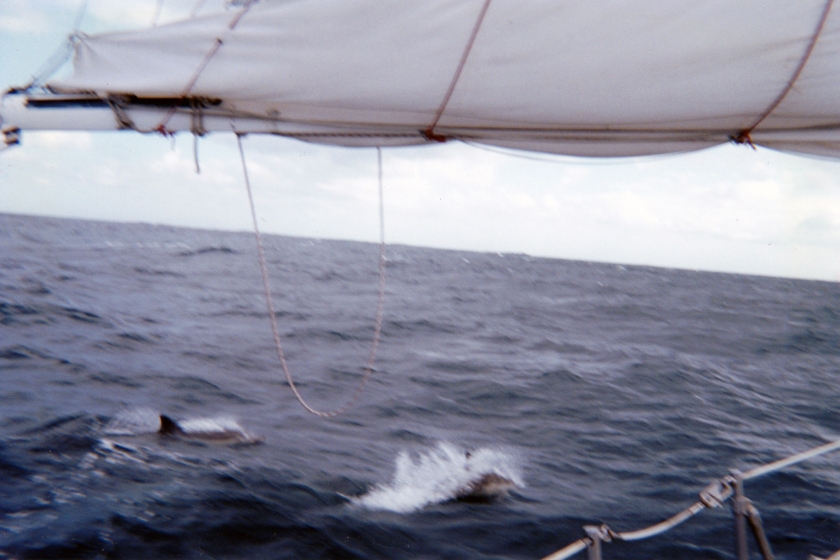
We couldn’t stay long though. We left the next morning and headed for Cabo while the manta (is manta plural of mantum?) were doing their warmups. The motoring was pretty uneventful until we came within sight of Cabeza Ballena. Once again we got 25 true on the nose and it stayed there until we were within a couple of hundred yards of the beach in Cabo. The wind died shortly after sunset but the anchorage rolled practically all night. Welcome back to the Pacific. We paid the twenty dollars and took a mooring for the next two nights. That portion of the bay is pretty flat. Ten bucks a night is a deal. While on the moorings we met “Windfall” and “Southern Cross”.
Gone was the balmy atmosphere of February. We found April is truly the coldest month in Cabo. It was warm enough once we were ashore but the Bahia was suffering from a bad case of spring. There were huge breakers going ashore at the newest timeshare and the sunbathers and volleyballers that crowded the beach in January were nowhere to be seen. Even the jet skiers could manage no more than a dull roar. The atmosphere was still as convivial as ever but there was an indefinable something lurking in the bushes. Regardless of how we might have felt though, some things about Cabo persist. Emboldened by our experience in La Paz we tried to use an agent to handle our check in and check out. After we picked ourselves up off the floor we asked them again. After we picked ourselves up off the floor we asked them still another time. 120.00 US dollars to do a 33 dollar job!! This, mind you, was a reduced rate for boats that were clearing in and out at the same time. Had we cleared in and out on 2 separate occasions the total would have been 152.00 US dollars. What a deal indeed! We thanked them profusely and got out of there before we tripped over our chins one more time. Marina De La Paz had charged us no more than what the actual fees were to handle clearing us in and out and they saved us considerable shoe leather to boot. Clearly we were back in Kansas.
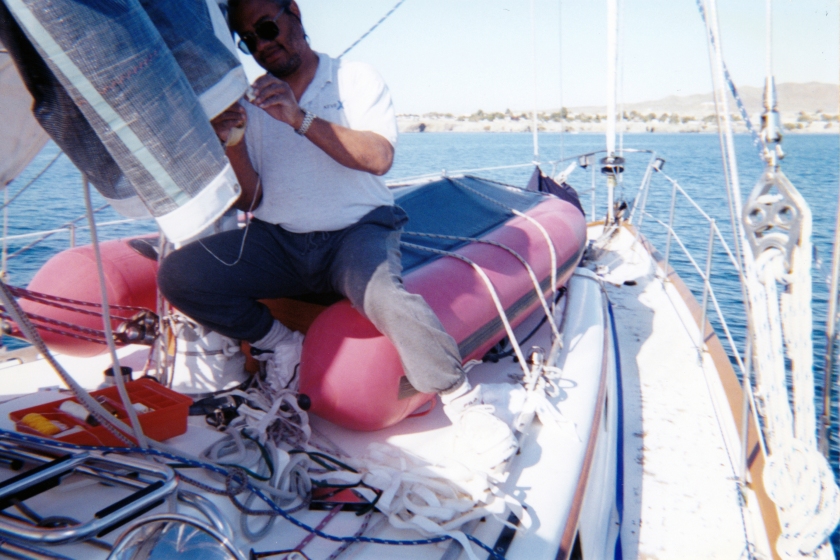
At 0600 in the morning of April fifth, we slipped our mooring and started the bash home. “Windfall” left the day before us and since they hadn’t returned it was the first good omen. We had fueled up, stocked up, emailed and or called our families and told them we’d be home soon. There was nothing left to do but face the wide open Pacific and go for broke. About an hour after we rounded El Arco another fuel filter clogged because the 5-foot seas driven by the 25-knot winds coming over Cabo Falso had stirred up all the water in the fuel we had just taken on. Luckily by then I could change a filter and bleed the engine before our speed dropped by half. The wind stayed on our nose at 25 for another 3 hours until we were well north of Falso. It moderated to about 12 true and we were actually making good time. We stayed about 5 miles offshore to take advantage of a reputed north flowing counter current as well as the reduced swell. As the morning wore on we picked up some chatter on the VHF from boats that had just rounded the point. They were all wondering the same thing we were a couple of hours earlier, namely just how long would it last. I hailed them and assured “Southern Cross” (Westsail 42) and “Gypsy Warrior” (Freya 39) that it would indeed moderate. We set up a contact schedule for further weather reports before getting back down to the business at hand, which was moving northward at the highest possible speed. Shortly after noon, we overheard another radio transmission between two completely different boats, “Santa Rosa” and “Quattro”. I broke in as they were signing off and found out that they were: roughly abreast of us, moving quite rapidly (7.5 knots to our 6), carried considerable fuel (about 750 gallons each), were headed directly for Turtle Bay instead of Mag Bay and that they were a couple of sports fisherman. I clearly remember thinking “We’ll never hear from them again”.
Murphy law says that “what can go wrong, will”. The law of the sea is about the same except it includes the phrase “at the worst possible time”. Shortly after dark, after we made the turn to bring us on course for Cabo Tosca, all hell broke loose. The wind jumped from 15 to 25 to 35 in a matter of minutes. The seas built just as rapidly and pretty soon we were stuffing our bow into as many waves as we were going over. “Gypsy Warrior” hailed us and told us that the news had just come in from an Amigo Net weather router that a fast moving cold front had surprised everyone and gone way south. It was due in our area shortly. By that time we had turned just south of due west and were riding it out quite comfortably. Luckily, it only lasted about an hour, but the lumpy seas never did flatten out. We had many more conversations with Rick on “Gypsy Warrior” that night. He was single-handing his boat home and was just as happy to have us to talk to as we were to have him. We took turns keeping each other up in the wee hours of that night and a lot more. We never heard from “Southern Cross” again. Most likely they turned back to Cabo.
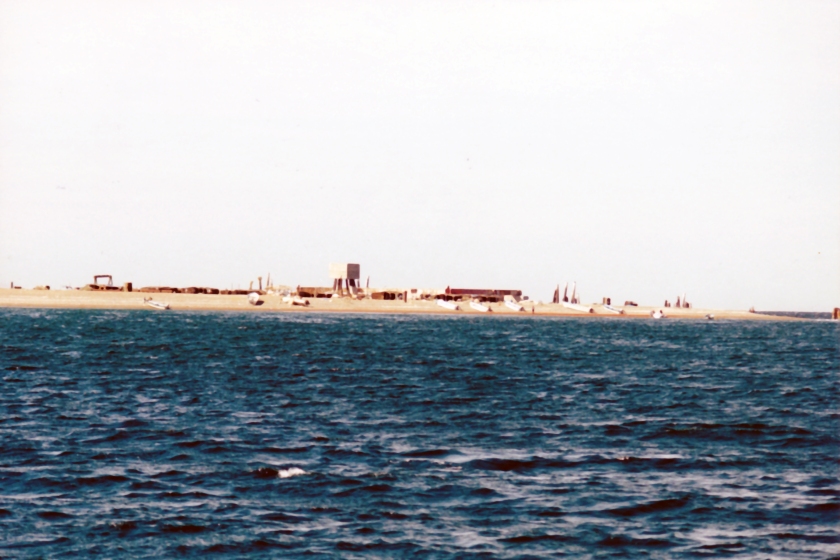
Our original schedule had us arrive in Mag Bay around noon on the 6th, some 30 hours later. This would have had us anchored in sheltered water just before the afternoon winds started to howl. Cabo Tosca at the south end and Cabo San Lazaro at the north are infamous for creating their own local weather. In between the two is a high mountainous wall broken only by the entrance to Mag Bay in the middle and Bahia Santa Maria at the north end. If we didn’t make it in by noon all this guaranteed we’d catch hell later on. Shortly before noon we were hit by the other side of the cold front and were slowed to a virtual standstill for another hour. We were still some 50 miles out. Rick stayed outside in order to drop into Mag Bay in one tack. We finally slid in under the lighthouse at Cabo Tosca and tacked our way up the 15-fathom line. Rick ran into a forty knot breeze out yonder but manage to get to Punta Belcher by 2230. We had dinner and a glass of cabernet and dropped anchor at 2330.
It wasn’t quite the same Punta Belcher we had arrived at in January. The fish camp was deserted. No lobster boat waited to sell us dinner. There was also a 2-knot current running which we hadn’t seen before and we lost control momentarily and came 10 feet of “Gypsy Warrior” when we stopped to drop the anchor. Rick had noticed it as well and had warned us but we weren’t prepared for its magnitude.

The next morning we overheard a very exhausted “Windfall” on the radio with Gregorio, the Puerto Magdalena port captain. Gregorio was trying to explain to “Windfall” that the fuel he wanted was on its way while “Windfall” was trying to convince Gregorio that he didn’t speak Spanish. Gregorio was actually speaking English but “Windfall” didn’t realize it. We hauled anchor in company with “Gypsy Warrior” and headed up to Puerto Magdalena ourselves in order to top off our tanks.
When we arrived Gregorio had finished with “Windfall” and was nowhere to be found. However, a panga full of enterprising fisherman approached us to see if we wanted fuel. After some haggling, mainly to make sure there were no hidden charges, they took off for Puerto San Carlos to get us 80 liters at 6 pesos per. While we waited we struck up a conversation with “Windfall”. They had left Cabo a full day before we did and arrived in Mag Bay only a few hours before us. They’re a delivery crew and get paid by the mile. They left later that evening for Turtle Bay despite predictions for very unsettled weather for the next three days. The admiral baked some cookies and we settled in for a long wait.
Sunday morning brought the tall ship “Californian” beating into the bay. We had heard snatches of VHF conversation between them and another vessel the previous Thursday. Apparently they rounded Cabo Falso shortly after we did but were just making it in. We found out later that they had a 100 horse engine which was totally inadequate for pushing a 140-ton ship upwind in those conditions. They had sailed the entire way and were still under sail when they dropped anchor. Onboard were 12 students as well as the regular crew. Rick and I dinghied over at the captain’s invitation to tour the ship.
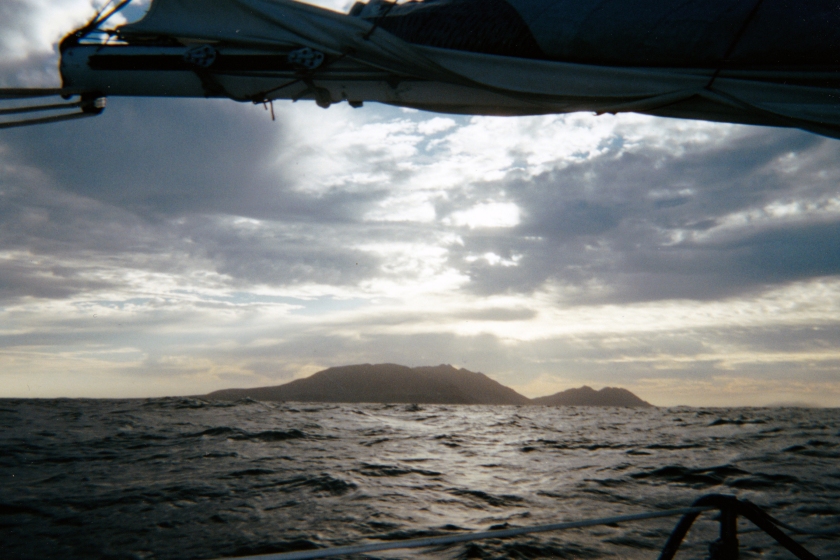
We left Puerto Magdalena early Monday to move up Bahia Santa Maria which put us 30 miles closer to Turtle Bay. The weather wasn’t about to let us move any further. About 1700 that evening we watched “Crystal” try to make her way past Cabo San Lazaro en route to Turtle Bay. Crystal is a 98’ motor yacht with a bow that slopes down to roughly 8 foot above the water. They were scooping waves up with their drooping snout and pushing them straight over their flybridge. When we arose the next morning “Crystal” was anchored behind us, apparently having given up sometime during the night. We hailed them that morning. They replied much later that afternoon. They had decided to turn back when the bilge alarm went off in the whaler stored on deck behind the flybridge. They told us a tale of woe second to none (up to that point). One crew member slipped down a flight of stairs and was in constant pain. Another crew member was due to be married that weekend in Newport Beach and was understandably anxious about getting home. The owner and his party jumped ship in Panama and flew home because “all the excitement was over”. Rick and I filled them in as best we could on the weather situation because, among other things, they lacked SSB, shortwave receiver and weather fax. Their only link with the outside world was a Globalstar sat phone over which they received weather forecasts from a router in San Diego and marching orders from the “boss” in Newport Beach. Their weather router had advised them to leave the night before. Carl, “Crystal’s” skipper thanked us profusely for our help with a half gallon of rum while Rick got a half gallon of rye. “Crystal” headed back to Puerto San Carlos to drop the about to be married crewman off so he could take a bus back.
“Consigliere” and “Royal Treat” arrived Wednesday. “Consigliere” is still the only sailboat we’ve encountered during the entire trip that did not have a dodger. The owner said he simply could not bear to mess up his boat’s lines with a dodger. The crew that sailed down with him in the ha-ha abandoned ship rather than face the entire trip home lashed to the wheel with buckets of Pacific Ocean smacking them in the face. His autopilot was giving him the blues as well.
When “Crystal” returned we were all invited over to enjoy a rather large tuna they bought while making the trip back to Puerto San Carlos. The Bahia Santa Maria Yacht Club was about to hold its first potluck. I had taken to welcoming arrivals to Bahia Santa Maria with a “will that be a temporary or full year membership” just to break the monotony. In fact, there are several de facto yacht clubs up and down the outer coast of Baja. The northern anchorage at Cedros Island is so well known that everyone refers to it simply as “THE Yacht Club”.
The Admiral prepares a salad with the last of our fresh vegetables. I’m busy trading with a local fisherman who dropped by with his panga loaded down with his family. He’s looking for “dulces” for his “ninos” and we just happen to have one bag of candy bars left. I select a nice fresh halibut from his catch and we’re both grinning. I clean it, cut it into steaks and bag it for the freezer. The admiral was a bit peeved that I gave away our candy but when I brought our latest catch below she remarks that it couldn’t possibly be a halibut because they stink so bad. I remind her that this one is fresh and suddenly she understands. I’m off the hook, all is forgiven.
We pick up Rick and buzz over to “Crystal” where the crews from “Consigliere” and “Royal Treat” are already waiting. Dinner, drinks, movies on the thirty-six inch TV, we could get used to this. The evening’s entertainment consists of a couple of Bogies out of the handful of video tapes I brought with me. We watch “Dark Passages” and “To Have and To Have Not” to round out the evening. Crystal doesn’t have a DVD player. I’m thinking “po’ bastards”. “Consigliere” loses their third crew member to “Crystal” when he decides that the “po’ bastards” need help in the worst way.
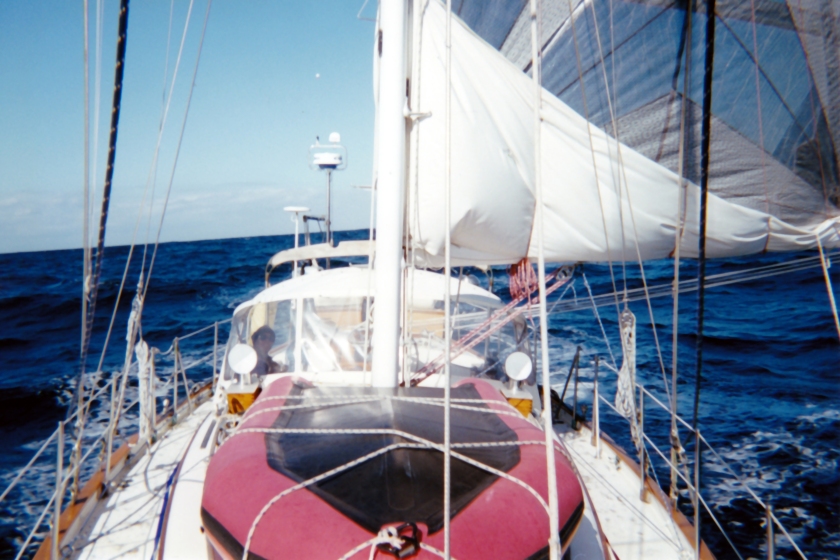
Thursday night the wind howls. I got up at midnight and again at two to check our position. Or more correctly she’s dragging. The instruments show a steady forty. The recorded peak was just over fifty. Crystal was 100 yards ahead and 100 yards to starboard of “Gypsy Warrior”. We’re one hundred yards behind “Gypsy Warrior”. By two am “Crystal” is a hundred yards off our starboard quarter.
For the first time our wind generator earns its keep. When we get up the batteries are charged. For the first time since we left La Paz, we don’t have to listen to the engine grinding away for ninety minutes to throw a charge into the batteries. Rick hails us. The amigo net is calling a three-day break in the weather. Anchor up, hammer down. Next stop Bahia Tortuga.
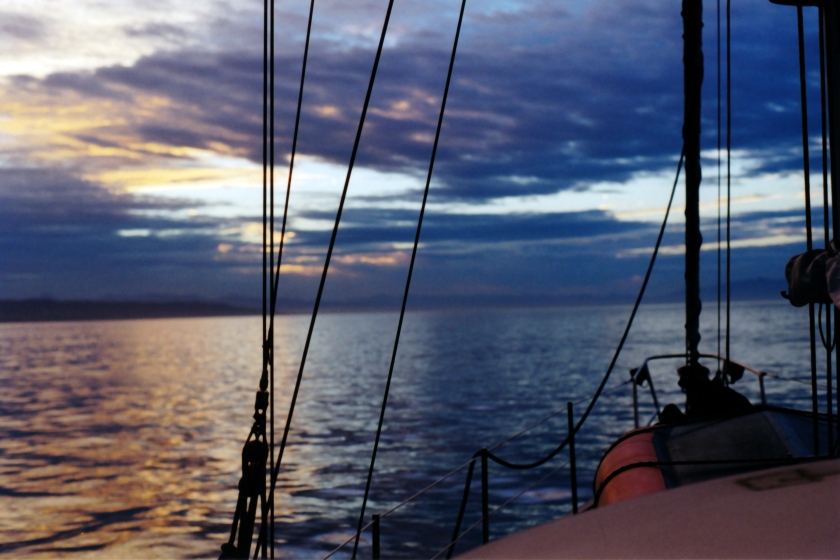
Just before noon, with Cabo San Lazaro still in plain sight in our rear view mirror, Rick hails us. His engine is pumping oil into the bilge. The auto club is more than six hundred miles away. We pass him two one gallon jugs of oil. A little later while we discuss alternatives via radio another boat breaks in. She is aptly named “Black Gold”. She is en route to Ensenada with a delivery crew and they have plenty of everything including oil. They pass Rick another five gallons without breaking stride and are gone. Later that evening we hear them announce their arrival in Turtle Bay by inviting anchored yachts to come over and fill their water tanks. We’re less than halfway there.
Saturday noon we’re ten miles off Ascuncion. Bahia Tortuga (Turtle Bay) is another fifty miles ahead of us. The afternoon breezes fill in and the previous twenty-four hours of calm become twenty-five knots on the nose once again. Our projected eleven PM arrival starts slipping slowly and definitely away. This time though, the wind dies a couple of hours after dark.
Forty-five hours later the anchor is down, set, and snubbed off. It’s five thirty-five Easter morning and we turn on the anchor light. At five forty-five the sun is blazing and we turn the anchor light back off. Just before we turn in I noticed two other sailboats anchored in the bay. One of them is “Windfall”.
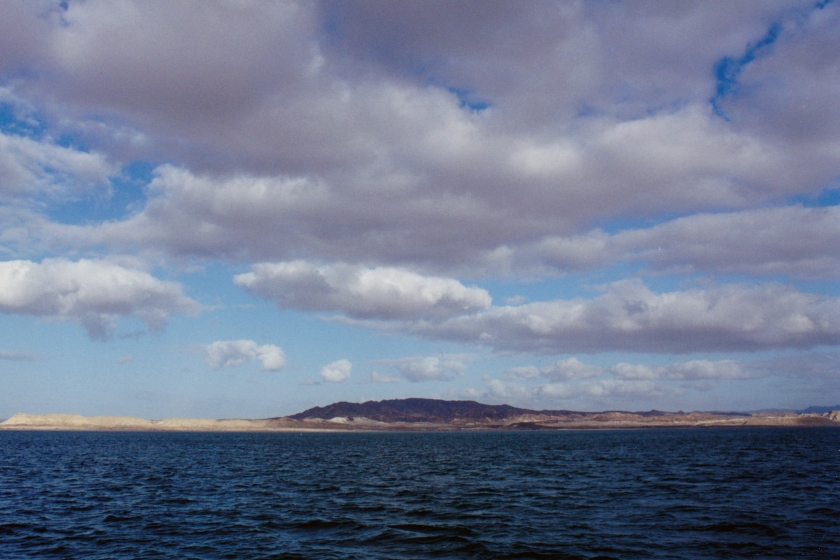
Just about nine in the am Ernesto pulls up in his panga and starts pounding on the hull. Since I’ve got to change the oil anyway… I order fifty gallons of diesel. Half expecting to see a quiet anchorage it’s a bit odd to see and hear a flurry around “Windfall” and a few curses coming from “Gypsy Warrior”. Eavesdropping on the VHF reveals that “Windfall” is dead in the water. Her engine has packed it in, her crew is abandoning ship, and the skipper… the skipper is losing it. He’s trying to relay a message to the owner via another boat’s SSB. We found out later that they’ve been there for two days, which works out to just over a week of travel time from Puerto Magdalena.
Rick discovered that his mysterious leak was no more than a seal that slipped off the dip stick and fell into the bilge. His flex coupling is also about to slip into the bilge. I have two spare drive savers but his transmission’s a Kanzaki. Mine’s a Volvo. Oh well…
After I change the oil for the sixth and last time and shower up we pick up Rick and head for shore. Rick has to do some shopping. After hiking all over town, he’s finally satisfied. He’s got: two potatoes, one pound of coffee, and a box of cornflakes. We stop at a little restaurant overlooking the bay and have a big dinner with several beers. This one was closed back in January when we passed through on the way down. The ha-ha crowd had trashed it the previous November and it had just reopened a scant two weeks earlier. Three chicken dinners and nine or ten, well let’s round it off and call it an even dozen beers. Hard to keep track on account of the admiral demanding Bohemias. Two hundred pesos later and we’ve spent the last of our Mexican money. And it is true what they say… “if you drink don’t drive”. I manage to catch a line in the outboard.
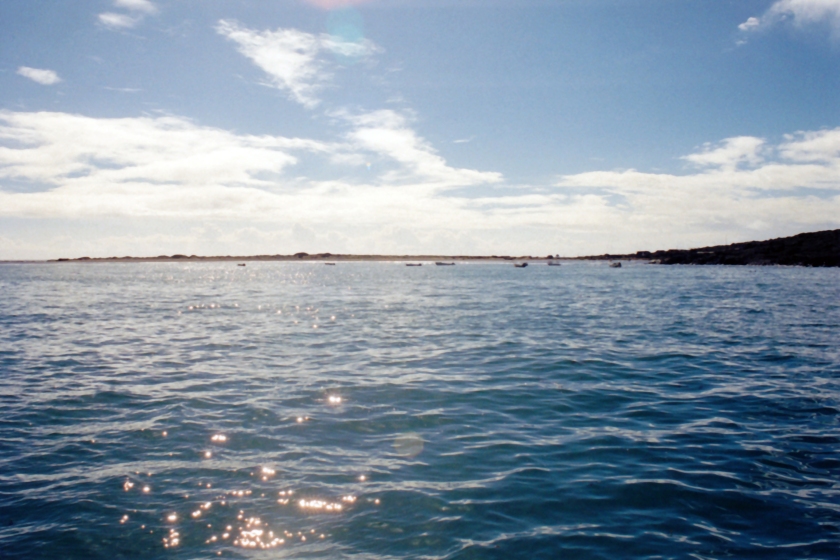
We leave bright and early Monday morning. We hadn’t gone far, only a couple of hours or so when we hear Coast Guard Group San Diego broadcasting on channel 16. We follow them to channel 22 and listen to the first full-length English weather bulletin we’ve heard since January. Three hundred ninety-five miles to go.
The going is rather easy. We’re in the lee of Isla Cedros for pretty much the entire day. It’s slightly overcast, the wind is blowing zero to five, and the seas are glassy with just a gentle swell running. Perfect conditions for heading north. It stays that way until five or so in the evening.
I was down below when we lurch, heel over about thirty degrees to port and then come right about a hundred and thirty degrees. I rush up on deck and luckily nothing and no one is near us. Rick is about one hundred yards behind us still heading northwest. In the meantime, we’re heading due east and our autopilot is struggling to bring us back on course. Between us is a rotary, a whirlpool. We had just skimmed the edge of it and it flung us around like so many feathers.
El Norte, the cliff that forms the north end of Isla Cedros is a shear wall that rises four thousand feet out of the water. The effect on local conditions is striking. As we pass into the clear the wind jumps from five to forty knots. I roll the throttle back to idle and fall off a bit. We’re doing nine knots under nothing but a double reefed main and the seas are still pretty flat.
We still had a pretty easy time of it. Broiled the last of the steaks, opened a nice merlot, had a green salad… Living the high life… until dark. The forty knot breeze off El Norte had been easing all evening till by the time darkness fell it was blowing a mere fifteen to twenty. Then the seas started picking up. Then the seas started coming at us from three different directions. Then the wind piped back up. By midnight we were miserable. The flag halyard had chafed through leaving our radar reflector and courtesy flag trailing in the water behind us. Water had forced its way through the seals on our brand new running lights again shorting another one out. We had both gotten soaked on watch sitting under the dodger by water coming over both quarters. Sleep was impossible… everything that was tied down has come loose… everything that’s loose is trying to smash itself into something else. Our speed is down to three knots and our fuel consumption way up. And we’re on vacation…by two in the morning we decide to forego our original destination, San Quintin and head for San Carlos.
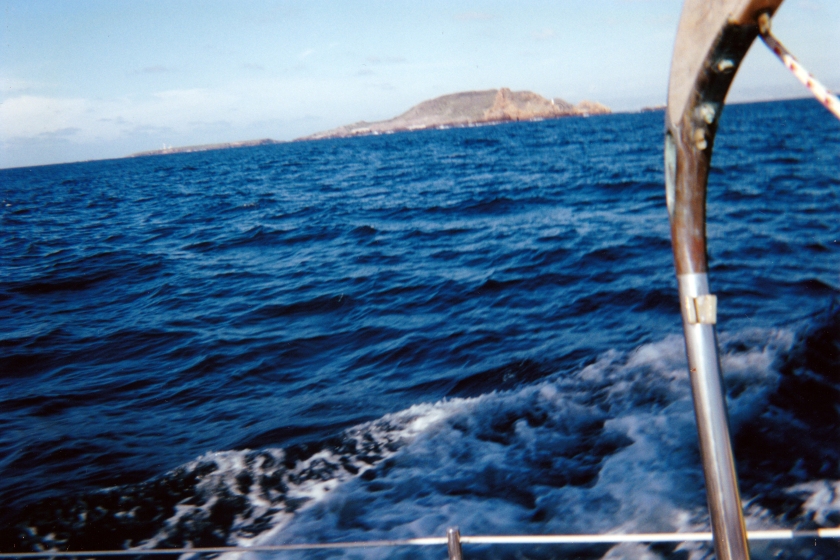
We were out of the slop by eleven the next morning. We anchored at one that afternoon. Two hundred fifty miles to go and the worst is officially behind us. We hope. Looking around the anchorage, there’s “Orion” a seventy foot Ocean Alexander, a couple of forty foot sailboats that I don’t recognize, “Gypsy Warrior” of course and way over in the corner all by her lonesome is “Santa Rosa”. “I’ll never hear from her again…” Right…
The San Carlos anchorage is the site of another four thousand foot cliff rising off the ocean floor. Because of this its mecca for windsurfers. I’m watching the folks riding the curl and fixing our running lights (again) when I begin to notice something peculiar about “Orion”.
“Damn big boat, that one is. Damn that’s a big boat. Jesus H., she’s really big! She’s getting bigger. OH SHIT! She’s dragging her hook!”
“Orion” has popped her anchor loose and she’s headed our way fast. There’s no time to haul anchor and move. I start the motor, give it full reverse, hoping to break our anchor loose. Nothing doing, we set it way too well as usual. Prop wash is moving us to port. Slowly. Into the wind. “Orion” passes so closely over our chain I can feel her hull scraping across it. Once she’s past I ease the throttle we start to swing back. Someone pops up on deck. I scream “get some goddamn fenders out”! He doesn’t speak English but he understood that. Moments later the captain comes up on deck dripping wet, dressed in a towel, and flip flops. He dashes up to the flybridge, starts the engines, and motors off. The admiral pokes her head out the companionway and demands to know what all that noise was about.
That afternoon “Orion” puts out a general call. Food and drinks for everybody. After potluck on “Crystal”, I’m game. The admiral takes a powder. She needs her beauty rest. I hav e to address the fuel situation first. The starboard tank had run dry during the night. We’ve got twenty gallons left in the jerry jugs. Gauge in the port tank works when it wants to. We can make San Quintin on what we have in the jugs. If we have to we can dinghy into town and pick up fuel there. I decide to empty the port lazarette and sound the tank manually. Lo and behold! The terminal slipped off the sender again. If I ever find the sucker that decided to use slip on terminals on boats… The gauge registers half a tank. If the weather moderates we can make Ensenada with no problem. “Orion” sends her dinghy around and picks us up this time. A little later “Consigliere” and “Royal Treat” arrive and the dinghy sent out again to bring them over.
Damn big boat… seeing as how we’re a little low on change we take the ten cent tour. The pilot house is big and roomy and well equipped and there are towels stuffed along the bottom edge of the windshield.
I said, “Looks like you got a little leakage”.
The captain said “Little? More like surf’s up”.
I said, “well, you got all the right equipment”.
He said “take a closer look at that SSB. That’s a crystal set. It doesn’t work and if it did it only has a couple of crystals. And this weather fax is brand new but there’s no paper.”
And I said “so you’re a delivery skipper”
And he said, “pleased to meet you”
After that, he showed us the capper. He took us down below to the forward stateroom. The carpet was soggy. The queen sized mattress had been stripped of its covers and was soaking wet. In fact, the whole cabin was wet. He pointed out where a porthole had once been and where a large piece of galley cutting board now resided. I look around at the rest of the ports and they’re plastic and failing to some degree or another. Half million dollar boat and its got plastic ports. He tells us that this port blew out several days ago when they tried to motor out beyond El Norte. He goes on to say that he noticed the boat started to feel heavy. He went down below to find water surging in with every wave and every roll. I remark that for a seventy footer to fell heavy would take several tons of water. He agreed and went on to say they came close to capsizing when they turned back.
Later, over drinks, I bring up the fact that he almost ran me down when his anchor drug earlier and that I hoped they did a better set this time. He apologized and told me it wasn’t the set, it was the anchor. They only had a Chinese CQR clone. It was stainless, it was pretty to look at, but it was only forty-five pounds and would have had trouble holding a thirty footer had it not been Chinese.
We met the skipper and crew of “Santa Rosa” that night. His name was Dan. The hired help had swum ashore at Cabo and more than likely walked home. He too was a delivery skipper. He too had been suckered in by an owner… the upshot was – everything leaked – hatches, ports, tanks – most everything else didn’t work or broke en route – refrigeration, pumps, one engine… I told him that after we broke radio contact just out of Cabo I was thinking that I’ll never see him again. We all laughed at that. His response was that he’s glad I didn’t run him down. We laughed even harder.
Next morning we had a forecast for clear and calm weather. This was great except we were fog bound. We were just south of the dreaded Sacramento reef, so named in honor of the steamer “Sacramento” which found it the hard way. “Gypsy Warrior” has radar. We have radar. “Consigliere” and “Royal Treat” have nothing. They follow us as soon as we get our anchor unstuck from the bottom. We run due west for four miles and turn northwest and head straight for San Quintin. After the turn, we’re out of the fog and straight into a record book perfect day. We anchor, and have a nice quiet dinner alone for a change. We simply want to sit and ponder our accomplishment for a while. At some point, we realize that no matter what we’ll never be the same again. We’ve done something many talk about but few accomplish. The worst is behind us. We’re in the lee of Point Conception from here on in and the sailing will be no worse than heading home from Catalina.
I get Rick on the radio and we decide to sleep in and leave about ten am which should put us in Ensenada just in time for the fuel dock to open the following morning.
The rest of the fleet with the exception of “Consigliere” and “Royal Treat” leave at daybreak. “Royal Treat” is having engine problems and “Consigliere” stays behind to lend assistance. This close to home they can sail it if need be. By five that evening, we pass the fleet which is anchored in the lee of another four thousand foot cliff. We hail them and they tell us its blowing thirty. We tell them that out where we are its barely hitting ten. We’re only five miles offshore. They stay put. We keep moving.
At five am Friday morning the sun was up and blazing away just as we entered Ensenada bay. A curious thing had happened since we were here in January. It had rained and the brown hills had turned green just like home. We make the fuel docks about six thirty, tie up and have Rick over for breakfast. We eat or toss everything on board. We don’t want to give anything to customs and immigration.
We filled our tanks with seventy gallons fuel at a buck fifty a gallon. This is the final stretch. It goes on a credit card. Who cares? At our top speed of eight and a half knots, we burn five gallons an hour. We turn the wick up to seven knots and for the first time leave Rick in our wake. At seven knots we’re barely burning two gallons an hour. Rick’s top speed is just a hair under that. Four o’clock that afternoon we finally passed into US waters. It’s easy to tell from the water. The Mexican side is marked with a large stone obelisk dedicated to the treaty of Hidalgo which set the modern day boundary. The US side has a large black chain link fence that starts in the surf and stretches out of site. I took down the Mexican courtesy flag and stored what remained of it away.
When you arrive in San Diego you’re supposed to go directly to the customs dock and notify customs of your arrival. We got there and found boats parked three deep all around the customs side and two deep around the Harbor Police side of the dock. There were border patrol boats, customs boats, coast guard boats and one large fishing trawler taking up every inch of space We circled the basin for an hour hoping the party would break up all the while trying to hail the Harbor Police on the VHF. There were crews from all these boats as well as shore police all standing around, laughing, talking and clearly having a good time about something or another. We finally pulled up close and the Admiral got the attention of one of the coasties. He told us we should just tie up at the transient dock and call customs from there.
The customs officer looked at our hailing port and asked us how long we’ve been in San Pedro. I think of home at Holiday Harbor and tell him “9 years”. He’s actually thinking of San Pedro, Mexico and gets this odd look on his face. I find it more than a bit amusing that this officer with a Spanish surname and of obvious Latino heritage working in San Diego has never heard of the west end of Los Angeles harbor. The pangueros in Baja were affected too, but in a more religious fashion. The dockworkers in La Paz also couldn’t pass by without reading the “San Pedro” out loud to each other. They may not have read their Rudyard Kipling but they knew their Saint Peter.
Rick and “Gypsy Warrior” make it in just after seven. Once he’s cleared in and settled down we take off on foot to do just what we had promised ourselves we would do that first night out of Cabo. We walk into the first open restaurant, get a table and order. Rick asks for a rare steak and washes it down with several shots of Lagavulin. The admiral wants a rare steak and a giant strawberry margarita with three umbrellas. I order a medium rare steak and a bottle of the cheapest white zinfandel they have in the house. Well chilled of course. And I picked up the tab.
25 May – 1 June 2001:
A tropical depression forms south of the Gulf of Tehuantepec. By the 29th, it’s a category 4 hurricane named Adolf (peak winds of 125 knots). By the 30th winds are down to 100 knots but the eye is 400 miles due south of Cabo. Hurricane season officially starts June 1st.
22 – 27 August 2003:
Hurricane Ignacio hits the southern portion of the Baja peninsula with torrential rains and hurricane-force winds. It tracks straight up the Sea of Cortez. Two deaths were reported. Light damage was reported in La Paz.
18 – 24 September 2003
Marty, a category 2 hurricane, makes landfall on the Pacific side of Baja California. It crosses over and on the 21st of September passes through La Paz. Marina Abaroa and Marina De La Paz are wiped out. Twenty plus boats sink. Many more are aground or damaged. Twelve deaths are reported, five in southern Baja. Four thousand homes are damaged or destroyed.
http://bajainsider.com/archive/marty/inside-marty01.htm
[1] The three behind “La Paloma” indicates this is a pretty popular name. Of lesser popularity were name like “Neriad” as there were only two. Since the “Neriad”s could be counted with only two fingers they were known as “Neriad-Tom” and “Neriad-Mike” after their respective owners. Of equal import, at least in my humble opinion was the paucity of “We’re Here”s and We’re Here II”s. Of even more concern was the number of people who thought of “We’re Here II” as a political, economic, or racial statement. Apparently only one cruiser ever heard of Rudyard Kipling and figured that the name “We’re Here” is from “Captains Courageous” and also correctly guessed that we owned more than one boat with that name. Whether or not there’ll be a “We’re Here III” has yet to be determined
